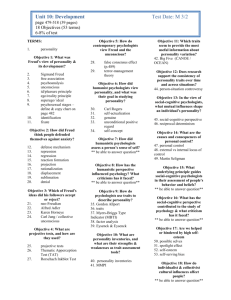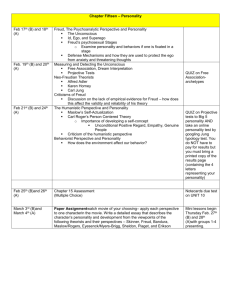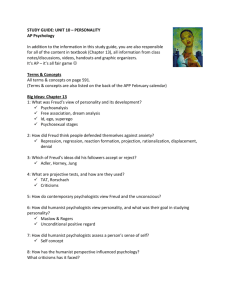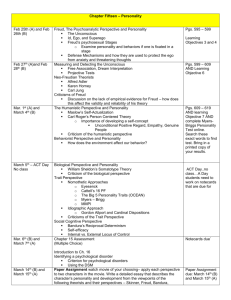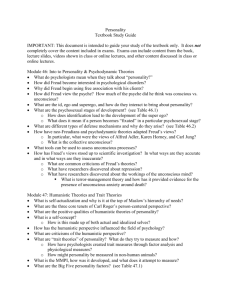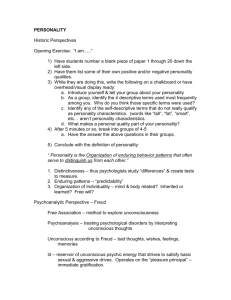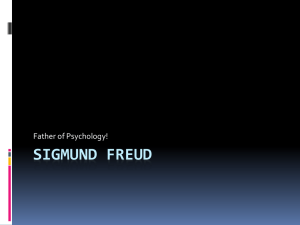UNIT 10 OVERVIEW: Personality Personality refers to each
advertisement
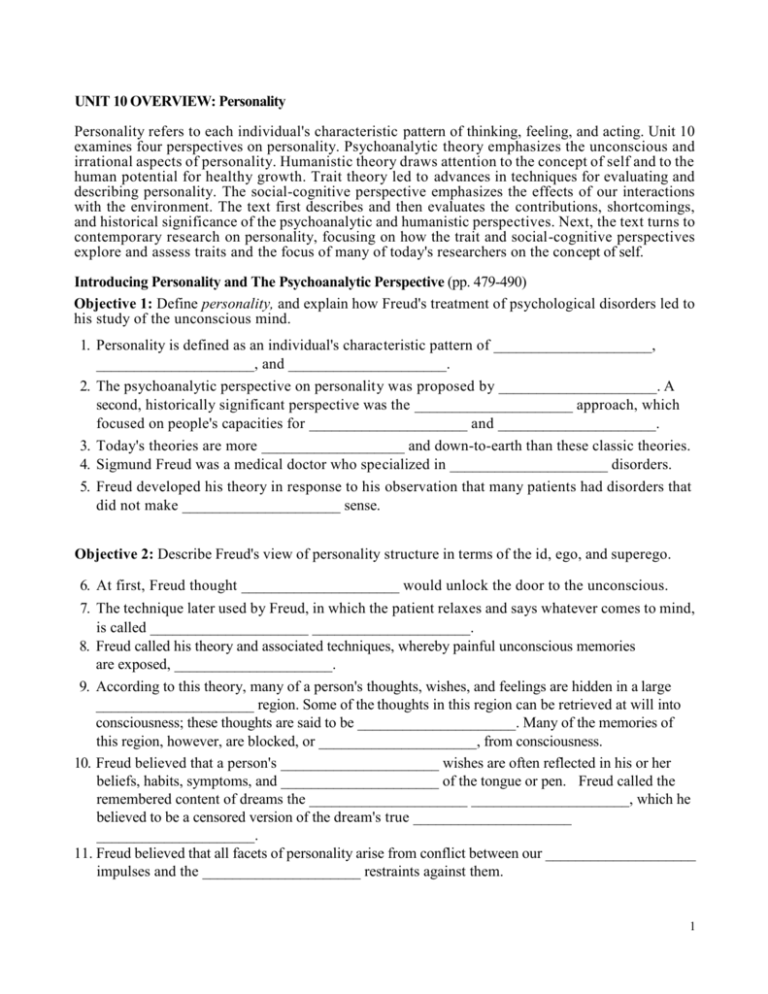
UNIT 10 OVERVIEW: Personality Personality refers to each individual's characteristic pattern of thinking, feeling, and acting. Unit 10 examines four perspectives on personality. Psychoanalytic theory emphasizes the unconscious and irrational aspects of personality. Humanistic theory draws attention to the concept of self and to the human potential for healthy growth. Trait theory led to advances in techniques for evaluating and describing personality. The social-cognitive perspective emphasizes the effects of our interactions with the environment. The text first describes and then evaluates the contributions, shortcomings, and historical significance of the psychoanalytic and humanistic perspectives. Next, the text turns to contemporary research on personality, focusing on how the trait and social-cognitive perspectives explore and assess traits and the focus of many of today's researchers on the concept of self. Introducing Personality and The Psychoanalytic Perspective (pp. 479-490) Objective 1: Define personality, and explain how Freud's treatment of psychological disorders led to his study of the unconscious mind. 1. Personality is defined as an individual's characteristic pattern of _____________________, _____________________, and _____________________. 2. The psychoanalytic perspective on personality was proposed by _____________________. A second, historically significant perspective was the _____________________ approach, which focused on people's capacities for _____________________ and _____________________. 3. Today's theories are more ___________________ and down-to-earth than these classic theories. 4. Sigmund Freud was a medical doctor who specialized in _____________________ disorders. 5. Freud developed his theory in response to his observation that many patients had disorders that did not make _____________________ sense. Objective 2: Describe Freud's view of personality structure in terms of the id, ego, and superego. 6. At first, Freud thought _____________________ would unlock the door to the unconscious. 7. The technique later used by Freud, in which the patient relaxes and says whatever comes to mind, is called _____________________ _____________________. 8. Freud called his theory and associated techniques, whereby painful unconscious memories are exposed, _____________________. 9. According to this theory, many of a person's thoughts, wishes, and feelings are hidden in a large _____________________ region. Some of the thoughts in this region can be retrieved at will into consciousness; these thoughts are said to be _____________________. Many of the memories of this region, however, are blocked, or _____________________, from consciousness. 10. Freud believed that a person's _____________________ wishes are often reflected in his or her beliefs, habits, symptoms, and _____________________ of the tongue or pen. Freud called the remembered content of dreams the _____________________ _____________________, which he believed to be a censored version of the dream's true _____________________ _____________________. 11. Freud believed that all facets of personality arise from conflict between our ____________________ impulses and the _____________________ restraints against them. 1 12. According to Freud, personality consists of three interacting structures: the ____________________, the _____________________, and the _____________________. 13. The id is a reservoir of psychic energy that is primarily _____________________ (conscious/ unconscious) and operates according to the _____________________ principle. 14. The ego develops _____________________ (before/after) the id and consists of perceptions, thoughts, and memories that are mostly _____________________ (conscious/unconscious). The ego operates according to the _____________________ principle. 15. Explain why the ego is considered the "executive" of personality. 16. The personality structure that reflects moral values is the _____________________, which Freud believed began emerging at about age _____________________. 17. A person with a _____________________ (strong/weak) superego may be self-indulgent; one with an unusually _____________________ (strong/weak) superego may be virtuous but guilt-ridden. Objective 3: Identify Freud's psychosexual stages of development, and describe the effects of fixation on behavior. 18. According to Freud, personality is formed as the child passes through a series of _________________ stages, each of which is focused on a distinct body area called an _____________________ _____________________. 19. The first stage is the _____________________ stage, which takes place during the first 18 months of life. During this stage, the id's energies are focused on behaviors such as _____________________. 20. The second stage is the _____________________ stage, which lasts from about age _____________ months to _____________ months. 21. The third stage is the _____________________ stage, which lasts roughly from ages ____________ to ________________ years. During this stage, the id's energies are focused on the _____________________. Freud also believed that during this stage children develop sexual desires for the _____________________ (same/opposite)-sex parent. Freud referred to these feelings as the _____________________ _____________________ in boys. Some psychoanalysts in Freud's era believed that girls experience a parallel _____________________ _____________________. 22. Freud believed that _____________________ with the same-sex parent is the basis for what psychologists now call _____________________ _____________________. 23. Explain how this complex of feelings is resolved through the process of identification. 24. During the next stage, sexual feelings are repressed: this phase is called the __________________ stage and lasts until puberty. 2 25. The final stage of development is called the _____________________ stage. 26. According to Freud, it is possible for a person's development to become blocked in any of the stages; in such an instance, the person is said to be _____________________. Objective 4: Discuss how defense mechanisms serve to protect the individual from anxiety. 27. The ego attempts to protect itself against anxiety through the use of _____________________ _____________________. The process underlying each of these mechanisms is _____________________. 28. Dealing with anxiety by returning to an earlier stage of development is called ________________. 29. When a person reacts in a manner opposite that of his or her true feelings, ___________________ ___________________is said to have occurred. 30. When a person attributes his or her own feelings to another person, _____________________ has occurred. 31. When a person offers a false, self-justifying explanation for his or her actions, ________________ has occurred. 32. When impulses are directed toward an object other than the one that caused arousal, _____________________has occurred. 33. When a person refuses to believe or even perceive a painful reality, he or she is experiencing _____________________. 34. Defense mechanisms are _____________________ (conscious/unconscious) processes. Matching Items Match each defense mechanism in the following list with the proper example of its manifestation. Defense Mechanisms _____ _____ _____ _____ _____ _____ 1. displacement 2. projection 3. reaction formation 4. rationalization 5. regression 6. denial a. nail biting or thumb sucking in an anxiety-producing situation. b. overzealous crusaders against “immoral behaviors” who don’t want to acknowledge their own sexual desires. c. saying you drink “just to be sociable” when in reality you have a drinking problem. d. thinking your child could not possible be taking drugs. e. thinking someone hates you when in reality you hate that person. f. a child who is angry at this parents and vents this anger on the family pet, a less threatening target. 3 Objective 5: Contrast the views of the neo-Freudians and psychodynamic theorists with Freud's original theory. 35. The theorists who established their own, modified versions of psychoanalytic theory are called _____________________- _____________________. These theorists typically place ______________ (more/less) emphasis on the conscious mind than Freud did and ______________ (more/less) emphasis on sex and aggression. Briefly summarize how each of the following theorists departed from Freud. a. Alfred Adler: b. Karen Horney: c. Carl Jung: 36. Today's psychologists _____________________ (accept/reject) the idea of inherited experiences, which _____________________ (which theorist?) called a _____________________ _____________________. 37. More recently, some of Freud's ideas have been incorporated into _____________________ theory. Unlike Freud, the theorists advocating this perspective do not believe that _____________________ is the basis of personality. They do agree, however, that much of mental life is __________________, that _____________________ shapes personality, and that we often struggle with _____________________ _____________________. Objective 6: Describe two projective tests used to assess personality, and discuss some criticisms of them. 38. Tests that provide people with ambiguous stimuli for interpretation are called __________________ tests. Henry Murray introduced the personality assessment technique called the _____________________ _____________________ Test. 39. The most widely used projective test is the _____________________, in which people are shown a series of _____________________. Critics contend that these tests have _____________________ (little/significant) validity and reliability. Objective 7: Summarize psychology's current assessment of Freud's theory of psychoanalysis, including its portrayal of the unconscious. 40. Contrary to Freud's theory, research indicates that human development is _____________________ (fixed in childhood/life long), children gain their gender identity at a(n) __________________ (earlier/later) age, and the presence of a same-sex parent _____________ (is/is not) necessary for the child to become strongly masculine or feminine. 4 41. Research also disputes Freud's belief that dreams disguise _____________________ and that defense mechanisms disguise _____________________ and _____________________ impulses. Another Freudian idea that is no longer widely accepted is that psychological disorders are caused by _____________________ _____________________. 42. Psychoanalytic theory rests on the assumption that the human mind often _____________________ painful experiences. Many of today's researchers think that this process is much _________________ (more common/rarer) than Freud believed. They also believe that when it does occur, it is a reaction to terrible _____________________. 43. Today's psychologists agree with Freud that we have limited access to all that goes on in our minds. Research confirms the reality of _____________________ _____________________ learning. 44. An example of the defense mechanism that Freud called _____________________ is what researchers today call the _____________________ _____________________ effect. This refers to our tendency to _____________________ the extent to which others share our beliefs and behaviors. 45. Another Freudian idea that has received support is that people defend themselves against _____________________. According to _____________________-_____________________ theory, when people are faced with a threatening world, they act to enhance their _____________________ and may adhere more strongly to the _____________________ that create meaning in their lives. 46. Criticism of psychoanalysis as a scientific theory centers on the fact that it provides _____________________-_____________________- _____________________ explanations and does not offer _____________________ _____________________. 47. State several of Freud's ideas that have endured. The Humanistic Perspective (pp. 490-493) Objective 8: Describe the humanistic perspective on personality in terms of Maslow's focus on self-actualization and Rogers' emphasis on people's potential for growth. 1. Two influential theories of humanistic psychology were proposed by _____________________ and _____________________. These theorists offered a __________________________________________ perspective that emphasized human _____________________. 2. According to Maslow, humans are motivated by needs that are organized into a ______________. Maslow refers to the process of fulfilling one's potential as _____________________ and the process of finding meaning, purpose, and communion beyond the self as ____________________. Many people who fulfill their potential have been moved by _____________________ _____________________ that surpass ordinary consciousness. 3. List some of the characteristics Maslow associated with those who fulfilled their potential. 5 4. According to Rogers, a person nurtures growth in a relationship by being ___________________, ____________________, and _____________________. 5. People who are accepting of others offer them _____________________ ____________________ ____________________. By so doing, they enable others to be _____________________ without fearing the loss of their esteem. 6. For both Maslow and Rogers, an important feature of personality is how an individual perceives himself or herself; this is the person's _____________________. Objective 9: Explain how humanistic psychologists assessed personality, and discuss the major criticisms of the humanistic perspective on personality. 7. Humanistic psychologists sometimes use _____________________ to assess personality, that is, to evaluate the _____________________. 8. One questionnaire, inspired by Carl Rogers, asked people to describe themselves both as they would _____________________ like to be and as they _____________________ are. When these two selves are alike, the self-concept is _____________________. 9. Some humanistic psychologists feel that questionnaires are _____________________ and prefer to use _____________________ to assess personality. 10. Humanistic psychologists have influenced such diverse areas as _____________________, _____________________, _____________________-_____________________, and _____________________. They have also had a major impact on today's _____________________ psychology. 11. State three criticisms of humanistic psychology. The Trait Perspective (pp. 493-503) Objective 10: Discuss psychologists' interest in personality types, and describe research efforts to identify fundamental personality traits. 1. Gordon Allport developed trait theory, which defines personality in terms of people's characteristic _____________________ and conscious _____________________. Unlike Freud, he was generally less interested in _____________________ individual traits than in _____________________ them. 2. The _____________________-_____________________ _____________________ _____________________ classifies people according to Carl Jung's personality types. Although recently criticized for its lack of predictive value, this test has been widely used in _____________________ and _____________________ counseling. 6 3. To reduce the number of traits to a few basic ones, psychologists use the statistical procedure of _____________________ _____________________. Hans and Sybil Eysenck think that two or three genetically influenced personality dimensions are sufficient; these include ________________ -_____________________ and emotional _____________________ - _____________________ 4. Some researchers believe that extraverts seek stimulation because their level of _________________ ___________________ is relatively low. PET scans reveal an area of the brain's ____________________ lobe that is less active in _____________________ (extraverts/introverts) than in _____________________ (extraverts/introverts). Dopamine and dopamine-related neural activity tend to be higher in _____________________ (extraverts /introverts). 5. Research increasingly reveals that our _____________________ play an important role in defining our _____________________ and _____________________ style. 6. Jerome Kagan attributes differences in children's _____________________ and _____________________ to autonomic nervous system reactivity. 7. Personality differences among dogs, birds, and other animals _______________ (are/are not) stable. Objective 11: Discuss the value of using personality inventories to assess traits, and identify the Big Five trait dimensions. 8. Questionnaires that categorize personality traits are called _____________________ _____________________. 9. The most widely used of all such personality tests is the_____________________ _____________________ _____________________ _____________________; its questions are grouped into ____________ (how many?) clinical scales. 10.This test was developed by testing a large pool of items and selecting those that differentiated particular individuals; in other words, the test was _____________________ derived. 11.Researchers have arrived at a cluster of five factors that seem to describe the major features of personality. List and briefly describe the Big Five. a. __________________________________________ b. __________________________________________ c. __________________________________________ d. __________________________________________ e. __________________________________________ 12. While some traits wane a bit during early and middle adulthood, others increase. For example, as young adults mature and learn to manage their commitments, _____________________ increases. From the thirties through the sixties, _____________________ increases. 13. In adulthood, the Big Five are quite _____________________ (stable/variable), with heritability estimated at _____________ percent or more for each dimension. Moreover, these traits _____________ (do/do not) predict other attributes. 7 Objective 12: Summarize the person-situation controversy, and explain its importance as a commentary on the trait perspective. 14. Human behavior is influenced both by our inner _____________________ and by the external _____________________. The issue of which of these is the more important influence on personality is called the _____________________ - _____________________ controversy. 15. To be considered a personality trait, a characteristic must persist over _____________________ and across _____________________. Research studies reveal that personality trait scores _____________________ (correlate/do not correlate) with scores obtained seven years later. The consistency of specific behaviors from one situation to the next is __________________________ (predictably consistent/not predictably consistent). 16. An individual's score on a personality test ____________ (is/is not) very predictive of his or her behavior in any given situation. 17. Explain the apparent contradiction between behavior in specific situations and average behavior patterns. 18. People's expressive styles, which include their _____________________, manner of _____________________, and _____________________, are quite _____________________ (consistent/inconsistent), which _____________________ (does/does not) reveal distinct personality traits. 19. (Thinking Critically About) Explain several techniques used by astrologers to persuade people to accept their advice. The Social-Cognitive Perspective (pp. 503-510) Objective 13: Describe the social-cognitive perspective, and discuss the important consequences of personal control and optimism. 1. Social-cognitive theory, which focuses on how the individual and the _____________________ interact, was proposed by _____________________. 2. Social-cognitive theorists propose that personality is shaped by the mutual influence of our internal _____________________, _____________________ factors, and _____________________ factors. This is the principle of _____________________ _____________________. 3. Describe three different ways in which the environment and personality interact. 8 4. In studying how we interact with our environment, social-cognitive theorists point to the importance of our sense of _____________________ _____________________. Individuals who believe that they control their own destinies are said to perceive an _____________________ _____________________ _____________________ _____________________. Individuals who believe that their fate is determined by outside forces are said to perceive an ____________________ _____________________ _____________________ _____________________. Self-control, which is the ability to control _____________________ and _____________________ gratification, predicts good _____________________, better _____________________, and ________________ success. 5. People who feel helpless and oppressed often perceive control as _____________________ and may develop 6. People become happier when they are given ______________ (more/less) control over what happens to them. 7. One measure of a person's feelings of effectiveness is his or her degree of _____________________. Our characteristic manner of explaining negative and positive events is called our _____________________ _____________________. 8. (Close-Up) During its first century, psychology focused primarily on understanding and alleviating _____________________ _____________________. Today, however, thriving Western cultures have an opportunity to create a more _____________________ psychology, focused on three pillars: a. __________________________________________ b. __________________________________________ c. __________________________________________ 9. Our natural positive-thinking bias can sometimes promote an _____________________ _____________________ about future life events that can be unhealthy. 10 . People tend to be most overconfident of their abilities in areas where they are, in fact, most _____________________ (competent/incompetent). Objective 14: Explain why social-cognitive researchers assess behavior in realistic situations, and state the major criticism of the social-cognitive perspective. 11. It follows from the social-cognitive perspective that the best means of predicting people's future behavior is their _______________________________________________________________. 12. The major criticism of the social-cognitive perspective is that it fails to appreciate a person's _____________________ _____________________. Exploring the Self (pp. 511-518) Objective 15: Explain why psychology has generated so much research on the self, and discuss the importance of self-esteem to human well-being. 1. One of Western psychology's most vigorously researched topics today is the _____________________. 2. Hazel Markus and colleagues introduced the concept of an individual's _____________________ __________________________________________to emphasize how our aspirations motivate us through specific goals. 9 3. Our tendency to overestimate the extent to which others are noticing and evaluating us is called the _____________________ _____________________. 4. According to self theorists, personality development hinges on our feelings of self-worth, or _____________________. People who feel good about themselves are relatively _____________________ (dependent on/independent of) outside pressures. 5. In a series of experiments, researchers found that people who were made to feel insecure were _______________ (more/less) critical of other persons or tended to express heightened _____________________ _____________________. Objective 16: Discuss some evidence for self-serving bias, and contrast defensive and secure self-esteem. 6. Research has shown that most people tend to have _________________ (low/high) self-esteem. 7. The tendency of people to judge themselves favorably is called the _____________________ bias. 8. Responsibility for success is generally accepted ________________ (more/less) readily than responsibility for failure. 9. Most people perceive their own behavior and traits as being _________________ (above/ below) average. 10. Bushman and Baumeister found that students with unrealistically ______________ (low/high) self-esteem were most likely to become exceptionally aggressive after criticism. 11. Some researchers distinguish _____________________ self-esteem, which is fragile and sensitive to _____________________, from _____________________ self-esteem, which is less focused on _____________________ evaluations. Objective 17: Identify some ways a primarily individualist culture differs from a primarily collectivist culture. 12. Cultures based on _____________________ value personal _____________________ and individual _____________________. Examples of such cultures occur in _____________________ _____________________, _____________________ _____________________, _____________________, and _____________________ _____________________. 13. In contrast, cultures based on _____________________ value _____________________, _____________________, and _____________________. Examples of such cultures occur in _____________________ _____________________, _____________________, and _____________________. 14. Whereas people in _______________ cultures value freedom, they suffer more ______________, divorce, _____________________ and _____________________related disease. 10 Matching Items Match each definition or description with the appropriate term. Terms a. id b. ego c. superego d. reaction formation e. rationalization f. displacement g. factor analysis h. projection i. TAT j. Rorschach k. MMPI Definitions or Descriptions ____ _____ ____ ____ ____ ____ ____ ____ ____ ____ ____ 1. redirecting impulses to a less threatening object 2. test consisting of a series of inkblots 3. the conscious executive of personality 4. personality inventory 5. disguising an impulse by imputing it to another person 6. switching an unacceptable impulse into its opposite 7. the unconscious repository of instinctual drives 8. a statistical technique that identifies clusters of personality traits 9. personality structure that corresponds to a person's conscience 10. providing self-justifying explanations for an action 11. a projective test consisting of a set of ambiguous picture Matching Items Match each term with the appropriate definition or description. Terms _____ _____ _____ _____ _____ _____ _____ _____ _____ _____ _____ 1. 2. 3. 4. 5. 6. 7. 8. 9. 10. 11. projective test identification collective unconscious reality principle psychosexual stages pleasure principle empirically derived test reciprocal determinism personality inventory Oedipus complex preconscious Definitions or Descriptions a. the id's demand for immediate gratification b. a boy's sexual desires toward the opposite-sex parent c. information that is retrievable but currently not in conscious awareness d. stages of development proposed by Freud e. questionnaire used to assess personality traits f. the two-way interactions of behavior with personal and environmental factors g. personality test that provides ambiguous stimuli h. the repository of universal memories proposed by Jung i. the process by which children incorporate their parents' values into their developing superegos j. the process by which the ego seeks to gratify impulses of the id in nondestructive ways k. developed by testing a pool of items and then selecting those that discriminate the group of interest 11

